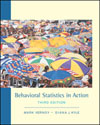 |  Behavioral Statistics in Action, 3/e Mark W. Vernoy,
Palomar College
Diana J. Kyle,
Fullerton College
Measures Of Central Tendency
Glossary
| Mean | is the score that, by weight, is the center of the distribution. Although all three measures of central tendency can be called averages, the mean is the value most people associate with the average. It is also the most commonly used measure of central tendency. The mean of a sample,  <a onClick="window.open('/olcweb/cgi/pluginpop.cgi?it=gif:: ::/sites/dl/free/0767422759/35691/c4gi1.gif','popWin', 'width=85,height=57,resizable,scrollbars');" href="#"><img valign="absmiddle" height="16" width="16" border="0" src="/olcweb/styles/shared/linkicons/image.gif"> (0.0K)</a> , or a population, <a onClick="window.open('/olcweb/cgi/pluginpop.cgi?it=gif:: ::/sites/dl/free/0767422759/35691/c4gi1.gif','popWin', 'width=85,height=57,resizable,scrollbars');" href="#"><img valign="absmiddle" height="16" width="16" border="0" src="/olcweb/styles/shared/linkicons/image.gif"> (0.0K)</a> , or a population,  <a onClick="window.open('/olcweb/cgi/pluginpop.cgi?it=gif:: ::/sites/dl/free/0767422759/35691/c4gi2.gif','popWin', 'width=83,height=57,resizable,scrollbars');" href="#"><img valign="absmiddle" height="16" width="16" border="0" src="/olcweb/styles/shared/linkicons/image.gif"> (1.0K)</a> , is the sum of all the scores divided by the total number of scores. <a onClick="window.open('/olcweb/cgi/pluginpop.cgi?it=gif:: ::/sites/dl/free/0767422759/35691/c4gi2.gif','popWin', 'width=83,height=57,resizable,scrollbars');" href="#"><img valign="absmiddle" height="16" width="16" border="0" src="/olcweb/styles/shared/linkicons/image.gif"> (1.0K)</a> , is the sum of all the scores divided by the total number of scores.
|  |  |  | | Measures of central tendency | are scores that represent the center of the distribution. The most common measures of central tendency are the mean, median, and mode.
|  |  |  | | Median | is the middle score of any set of raw scores. When the scores in a distribution are ranked or placed in numerical order, half are above and half are below the median. If there is an odd number of scores, the median is the middle score. If there is an even number of scores, the median is the mean of the two middle scores.  <a onClick="window.open('/olcweb/cgi/pluginpop.cgi?it=gif:: ::/sites/dl/free/0767422759/35691/c4gi3.gif','popWin', 'width=292,height=66,resizable,scrollbars');" href="#"><img valign="absmiddle" height="16" width="16" border="0" src="/olcweb/styles/shared/linkicons/image.gif"> (2.0K)</a> <a onClick="window.open('/olcweb/cgi/pluginpop.cgi?it=gif:: ::/sites/dl/free/0767422759/35691/c4gi3.gif','popWin', 'width=292,height=66,resizable,scrollbars');" href="#"><img valign="absmiddle" height="16" width="16" border="0" src="/olcweb/styles/shared/linkicons/image.gif"> (2.0K)</a>
 <a onClick="window.open('/olcweb/cgi/pluginpop.cgi?it=gif:: ::/sites/dl/free/0767422759/35691/c4gi4.gif','popWin', 'width=416,height=88,resizable,scrollbars');" href="#"><img valign="absmiddle" height="16" width="16" border="0" src="/olcweb/styles/shared/linkicons/image.gif"> (4.0K)</a> <a onClick="window.open('/olcweb/cgi/pluginpop.cgi?it=gif:: ::/sites/dl/free/0767422759/35691/c4gi4.gif','popWin', 'width=416,height=88,resizable,scrollbars');" href="#"><img valign="absmiddle" height="16" width="16" border="0" src="/olcweb/styles/shared/linkicons/image.gif"> (4.0K)</a>
|  |  |  | | Mode | is the most frequently occurring score in the distribution. When the scores in a distribution are ranked or placed in numerical order and one score is the most frequent, the distribution is unimodal. A distribution is called bimodal and has two modes when two different scores tie for the most frequent score. When there are more than two modes, the distribution is multimodal. However, if the distribution consists of only one of each score, it has n modes or as many modes as there are scores.
|  |  |  | | Skew | refers to the general shape of a distribution of scores when graphed as a frequency polygon. There is zero skew when the shape of the distribution is symmetrical. It is skewed when most of the scores are at one end of the distribution and very few are at the other end. The tails of distributions are the areas at the extreme high or low end where the data tapers off to zero -- where the graph approaches the abscissa. The skew is positive when the tail points in the positive direction and negative when it is pointing in the negative direction.
|
|



 2002 McGraw-Hill Higher Education
2002 McGraw-Hill Higher Education
